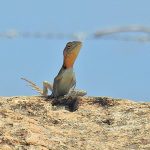TOMMY ROUNDHEAD DRAGON
The Tommy roundhead dragon is a petite reptile, typically measuring around 10 to 15 centimetres in length, including its tail. Its body is adorned with a palette of earthy browns and greys, perfectly camouflaged against the sandy soils and leaf litter of its habitat. This dragon’s most distinctive feature is its rounded head, which gives it a gentle, almost amiable appearance. The scales are small and smooth, allowing it to blend seamlessly into its surroundings.
The Tommy roundhead dragon calls the open woodlands and grassy plains of northern Australia home. This includes regions across Queensland and the Northern Territory. The dragon thrives in areas where it can bask under the sun and find ample shelter amongst rocks and low vegetation. Like many reptiles, they are ectothermic, relying on external heat sources to regulate their body temperature. You’ll often find them basking in the sun during the early morning and late afternoon.
A day in the life of a Tommy roundhead dragon involves foraging for food, which primarily consists of insects. These agile hunters feast on ants, beetles, and other small invertebrates, using their quick reflexes to capture prey.
The breeding season for the Tommy roundhead dragon aligns with the warmer months, typically from September to March. During this time, males may be seen displaying their vibrant throat colours to attract females. After mating, the female will lay a clutch of eggs in a carefully chosen spot, often a sandy area where the warmth of the sun can incubate them. The eggs hatch after several weeks, releasing tiny replicas of the adults, ready to start life in the wild. Males can be quite territorial, often seen defending their space from rivals during the breeding season.
In the wild, the Tommy roundhead dragon can live for several years, although exact lifespan data is limited. Their survival is closely linked to their ability to avoid predators and find sufficient food. Their ability to blend into their environment is crucial for avoiding predators like birds and larger reptiles.
Unlike birds or mammals, the Tommy roundhead dragon is not known for vocalisations. Instead, it communicates through body language and visual signals, such as head-bobbing and colour displays, particularly during mating rituals or territorial disputes.
The Tommy roundhead dragon is a testament to the remarkable adaptability and diversity of Australia’s wildlife. Its presence enriches the ecosystems it inhabits, serving as both predator and prey in the intricate web of life.







